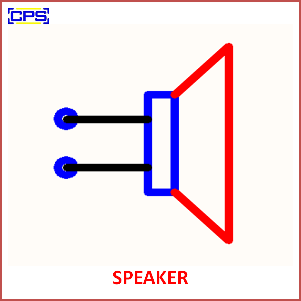A Speaker is an electroacoustic transducer that converts electrical signals into sound waves, making audio signals audible to humans. It achieves this by vibrating a diaphragm in response to the variations in the electrical signal, producing corresponding sound waves in the air.

Key Features of a Speaker
- Components:
- Diaphragm/Cone: Vibrates to produce sound.
- Voice Coil: Generates a magnetic field when current flows through it, interacting with a permanent magnet.
- Magnet: Provides a steady magnetic field for the voice coil to interact with.
- Frame: Holds the components in place.
- Suspension: Maintains the alignment of the moving parts.
- Frequency Response:
- Determines the range of sound frequencies the speaker can produce, typically measured in Hertz (Hz).
- Impedance:
- Measured in ohms (Ω), indicating the electrical resistance of the speaker.
Types of Speakers:
- Dynamic Speakers:
- Most common type, using a voice coil and magnet.
- Electrostatic Speakers:
- Use a charged diaphragm between conductive plates.
- Piezoelectric Speakers:
- Use piezoelectric materials to generate sound.
- Subwoofers and Tweeters:
- Specialized for low and high frequencies, respectively.
Applications of Speakers:
- Consumer Electronics:
- Found in TVs, smartphones, and home theater systems.
- Public Address Systems:
- Used for amplifying sound in large spaces.
- Automotive Systems:
- Integrated into vehicles for entertainment and alerts.
- Professional Audio:
- Used in concerts and studios for high-quality sound reproduction.
Advantages:
- Converts electrical energy into sound efficiently.
- Available in various sizes and designs for specific applications.
- Capable of producing a wide range of sound frequencies.
Disadvantages:
- Requires power and can consume significant energy.
- Sound quality may degrade due to wear or damage over time.
- Performance varies with design, size, and material quality.
